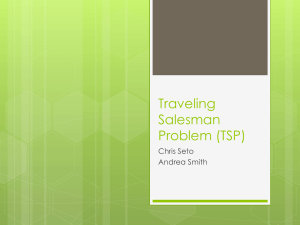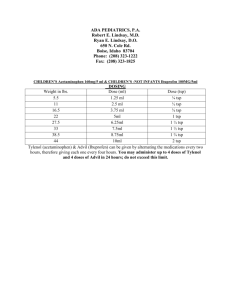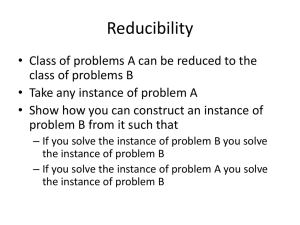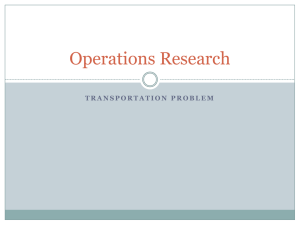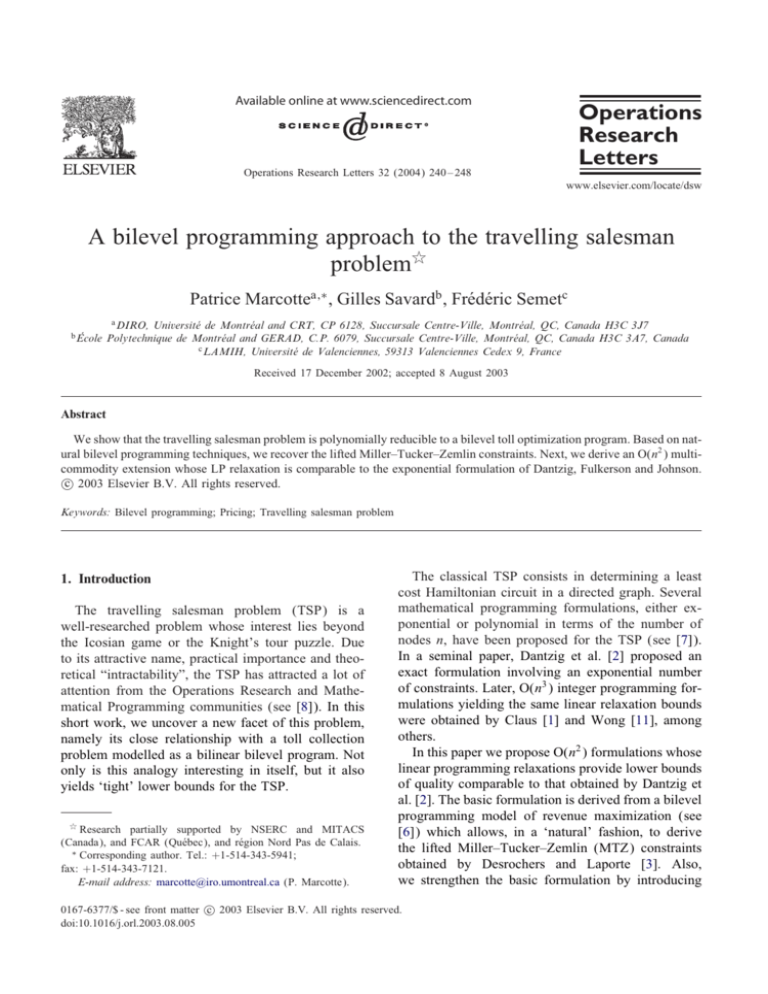
Available online at www.sciencedirect.com
Operations Research Letters 32 (2004) 240 – 248
Operations
Research
Letters
www.elsevier.com/locate/dsw
A bilevel programming approach to the travelling salesman
problem
Patrice Marcottea;∗ , Gilles Savardb , Fr'ed'eric Semetc
b Ecole
a DIRO, Universit
e de Montreal and CRT, CP 6128, Succursale Centre-Ville, Montreal, QC, Canada H3C 3J7
Polytechnique de Montreal and GERAD, C.P. 6079, Succursale Centre-Ville, Montreal, QC, Canada H3C 3A7, Canada
c LAMIH, Universit
e de Valenciennes, 59313 Valenciennes Cedex 9, France
Received 17 December 2002; accepted 8 August 2003
Abstract
We show that the travelling salesman problem is polynomially reducible to a bilevel toll optimization program. Based on natural bilevel programming techniques, we recover the lifted Miller–Tucker–Zemlin constraints. Next, we derive an O(n2 ) multicommodity extension whose LP relaxation is comparable to the exponential formulation of Dantzig, Fulkerson and Johnson.
c 2003 Elsevier B.V. All rights reserved.
Keywords: Bilevel programming; Pricing; Travelling salesman problem
1. Introduction
The travelling salesman problem (TSP) is a
well-researched problem whose interest lies beyond
the Icosian game or the Knight’s tour puzzle. Due
to its attractive name, practical importance and theoretical “intractability”, the TSP has attracted a lot of
attention from the Operations Research and Mathematical Programming communities (see [8]). In this
short work, we uncover a new facet of this problem,
namely its close relationship with a toll collection
problem modelled as a bilinear bilevel program. Not
only is this analogy interesting in itself, but it also
yields ‘tight’ lower bounds for the TSP.
Research partially supported by NSERC and MITACS
(Canada), and FCAR (Qu'ebec), and r'egion Nord Pas de Calais.
∗ Corresponding author. Tel.: +1-514-343-5941;
fax: +1-514-343-7121.
E-mail address: marcotte@iro.umontreal.ca (P. Marcotte).
The classical TSP consists in determining a least
cost Hamiltonian circuit in a directed graph. Several
mathematical programming formulations, either exponential or polynomial in terms of the number of
nodes n, have been proposed for the TSP (see [7]).
In a seminal paper, Dantzig et al. [2] proposed an
exact formulation involving an exponential number
of constraints. Later, O(n3 ) integer programming formulations yielding the same linear relaxation bounds
were obtained by Claus [1] and Wong [11], among
others.
In this paper we propose O(n2 ) formulations whose
linear programming relaxations provide lower bounds
of quality comparable to that obtained by Dantzig et
al. [2]. The basic formulation is derived from a bilevel
programming model of revenue maximization (see
[6]) which allows, in a ‘natural’ fashion, to derive
the lifted Miller–Tucker–Zemlin (MTZ) constraints
obtained by Desrochers and Laporte [3]. Also,
we strengthen the basic formulation by introducing
c 2003 Elsevier B.V. All rights reserved.
0167-6377/$ - see front matter doi:10.1016/j.orl.2003.08.005
P. Marcotte et al. / Operations Research Letters 32 (2004) 240 – 248
commodities and demonstrate, through numerical
experiments, the inOuence of the number of commodities on the quality of the lower bound.
s:t:
x;y
k∈K
a∈A1
a∈A2
(xak + yak ) = bki
∀k ∈ K
∀i ∈ N;
2. A toll optimization problem
At the lower level, the variable xak (respectively yak )
represents the number of commodity k users that travel
on arc a ∈ A1 (respectively on arc a ∈ A2 ).
For a given toll vector T , we assume that users
minimize their individual generalized travel costs, i.e.,
users are assigned to shortest paths linking their respective departure and arrival nodes. The corresponding lower level mathematical program, parameterized
in the toll vector T , is
k
k
min
(ca + Ta )xa +
da y a
a∈i+
a∈i−
xak
A bilevel program describes a hierarchical structure where the feasible set of a leader is contingent
on the follower’s optimal reaction to the leader’s
decisions. In [6], Labb'e et al. formulated the toll
optimization problem (TOP) as a bilevel program
where the leader (upper level) sets tolls on a subset
of arcs of a transportation network, while the followers (lower level) travel on shortest paths with respect
to a generalized cost. More precisely, let us consider
a multi-commodity network where each commodity
k ∈ K is associated with an origin–destination pair
(o(k); d(k)) of a transportation network G with node
set N and arc set A, the latter being partitioned into
the subset A1 of toll arcs and the complementary
subset A2 of toll-free arcs. With each arc a of A1
is associated a generalized travel cost composed of a
Pxed part ca representing the unit travel cost and a
toll Ta . Any toll-free arc a of A2 bears a Pxed unit
travel cost da .
We denote by {nk }k∈K the demand for commodity
k, a negative demand corresponding to supply, and
introduce the nodal demands
k
if i = o(k);
−n
bki =
nk if i = d(k);
0
otherwise:
(xak + yak ) −
241
¿0
∀k ∈ K
∀a ∈ A1 ;
yak ¿ 0
∀k ∈ K
∀a ∈ A2 ;
(1)
where i+ (respectively i− ) denotes the set of outgoing (respectively incoming) arcs incident to node i.
A set of revenue-maximizing tolls is then obtained by
solving the program
max
Ta
xak
T
s:t:
a∈A1
k∈K
Tamin 6 Ta 6 Tamax
∀a ∈ A1 ;
(2)
where it is understood that the Oow variables are optimal solutions of the lower level program (1). Whenever the lower level solution is not unique, we assume
that ties are broken in the leader’s favour. This is in
accordance with usual bilevel practice, and serves our
theoretical purpose.
The membership of TOP in NP follows from a property shared with linear programming: if TOP has an
optimal solution, then there exists an optimal solution
which is a vertex of a suitably dePned polyhedron P.
In other words, TOP can be viewed as a combinatorial optimization problem dePned over the vertices of
P, rather than a continuous (nonconvex) mathematical
program. This combinatorial problem has been shown
to be NP-hard by Labb'e et al. [6].
3. Reformulating the TSP as a TOP
In this section, we formulate the TSP as a
single-commodity TOP. This is achieved in two steps:
Prst, we adapt the reduction from the Hamiltonian
path problem (HPP) to TOP proposed in [6] to the
Hamiltonian circuit problem (HCP); next, we extend
this reduction technique to the TSP, taking the cost
structure into account.
3.1. Equivalence of the HCP and TOP
Given a directed graph G = (N; A), the HCP consists in determining an elementary circuit that passes
242
P. Marcotte et al. / Operations Research Letters 32 (2004) 240 – 248
through each node of N. We dePne a TOP model by
specifying
• its underlying graph,
• its cost structure,
• lower and upper bounds on tolls.
Since TOP involves paths rather than circuits, it is
convenient to transform the HCP into an equivalent
HPP. This is achieved by duplicating node 1 (its image is denoted n + 1) and replacing, for i distinct from
either the origin or destination node, arc (i; 1) ∈ A by
arc (i; n + 1). Looking for a Hamiltonian circuit in the
original graph is equivalent to identifying a Hamiltonian path from node 1 to node n + 1.
Let us identify the arc set A1 of the modiPed graph
with the set of toll arcs, and let us incorporate a single toll-free arc (1; n + 1). The resulting graph is denoted by G = (N; A) with N = N ∪ {n + 1} and
A = A1 ∪ {(1; n + 1)}. We associate with the origin–
destination pair (1; n+1) a unit demand, with each toll
arc (i; j) ∈ A1 a Pxed cost of −1, and set the cost of
the toll-free arc (1; n + 1) to n. Finally, a lower bound
of 2 is imposed on all tolls, and the upper bound is set
to +∞.
Our aim is to show that there exists a Hamiltonian
circuit in G if and only if the optimal revenue of the
above TOP is equal to 2n. First, let us note that the
revenue cannot exceed 2n. Indeed, all arc costs (inclusive of toll) being positive, the lower level solution is
an elementary path. Since Pxed costs on toll arcs are
set to −1 and that the cost of the shortest path is less
or equal to n (there exists a toll-free path from node 1
to n + 1 of cost n), an upper bound on the revenue associated with an optimal path using l arcs is given by
n − (l × (−1)) = n + l:
This bound corresponds to the diRerence between the
cost of the shortest toll-free path and the Pxed cost of
any path using l arcs. Hence, a revenue of 2n can only
be generated by a shortest path using exactly n arcs,
i.e., a Hamiltonian path.
Conversely, assume that there exists a Hamiltonian
path p between nodes 1 and n + 1. For each arc (i; j)
on p, set the toll variables Tij to their common lower
bound 2, and to n − 1 on arcs outside p. Under this
cost structure, the shortest path is clearly p and the
corresponding revenue is 2n.
Note that the marginal benePt raised on any given
toll arc decreases with increasing toll value. For instance, if the toll is set at its lower bound 2, the arc
cost is equal to 1; this leads to a benePt/cost ratio of
2, while a toll set at 3 results in a ratio of 1.5. Intuitively, it is to the leader’s advantage to set the toll
as low as possible, thus inducing the users to travel
on the longest possible path, e.g., a Hamiltonian path.
Of course, all tolls on the arcs that are not part of the
Hamiltonian path should be set at a value high enough
to discourage their use. The argument relies heavily
on the negativity of the Pxed costs and on the lower
bound on tolls, which prevents the benePt/cost ratio
of growing inPnite.
3.2. A TOP formulation of the TSP
By perturbing slightly the cost and bound structure
in the TOP formulation of the HPP, one may preserve
the ‘benePt/cost ratio’ principle, while favouring the
least cost paths. Accordingly, the users will travel on a
long (Hamiltonian) path of lowest cost, i.e., an optimal
Travelling Salesman tour. In the perturbed problem,
the Pxed cost of toll arc (i; j) is set to −1 + cij =L and
the lower bound on the corresponding toll is set at
2 − cij =L, where L is an upper bound on the cost of
an optimal tour, for instance L = n × max(i; j)∈A {cij }.
This yields the bilevel program
TOP–TSP : max
Tij xij
T
s:t:
min
x
s:t:
(i; j)∈A1
cij
∀(i; j) ∈ A1 ;
L
cij + Tij xij
−1 +
L
Tij ¿ 2 −
(i; j)∈A1
+nx1(n+1)
xji −
j|( j; i)∈A
−1
1
=
0
xij ¿ 0
xij
j|(i; j)∈A
if i = 1;
if i = n + 1;
otherwise;
∀(i; j) ∈ A:
P. Marcotte et al. / Operations Research Letters 32 (2004) 240 – 248
We now show that the optimal solution of TOP–TSP
yields tolls that induce an assignment of lower level
Oows to a shortest Hamiltonian path. To this aim, let
p(T ) denote an optimal path for a given toll vector T .
If p(T ) uses l arcs, we have that
cij 6 n;
(3)
−1 + Tij +
L
(i; j)∈p(T )
which yields the inequalities
n + l ¿ revenue =
Tij
(i; j)∈p(T )
¿
2−
(i; j)∈p(T )
= 2l −
1
L
s:t:
cij ¿ 2l − 1:
(i; j)∈p(T )
It follows that a revenue larger than 2n−1 can only be
achieved by inducing the follower to travel on a path
of length n, i.e., a Hamiltonian path pH (T ). In order
that the cost of this path be competitive with the cost
of the toll-free path, inequality (3) must hold. For a
given Hamiltonian path pH (T ), the maximal revenue
is obtained when the equality
1 Tij = 2n −
cij
L
(i; j)∈pH (T )
operations on a bilevel program and obtain, as
a consequence, the lifted version of the Miller–
Tucker–Zemlin formulation of the TSP proposed by
Desrochers and Laporte [3]. First, we replace the
lower-level shortest path program by its optimality conditions, to derive the equivalent single-level
program:
Tij xij
MIP : max
T; x
cij L
(i; j)∈pH (T )
holds. This can easily be achieved by setting the tolls
on the arcs of pH at their lower bound, and the remaining tolls at L. The optimal path corresponds,
clearly,
to a Hamiltonian path p∗ of minimal cost (i; j)∈p∗ cij
in the graph G . In the original graph G, p∗ corresponds to a Hamiltonian tour of minimum cost, i.e., a
solution of the TSP. One possible choice for the toll
vector T is, as indicated above
2 − cij if (i; j) ∈ p∗ ;
∗
L
(4)
Tij =
L
if (i; j) ∈ p∗ :
The choice of the constant L ensures that any alternative path has a cost higher than p∗ .
3.3. A mixed integer formulation for the TSP
In this section, we reformulate TOP–TSP as a mixed
integer program (MIP) by performing standard
243
(i; j)∈A1
xji −
j|( j; i)∈A
−1
1
=
0
xij
j|(i; j)∈A
if i = 1;
if i = n + 1;
otherwise;
j − i 6 − 1 + Tij +
cij
L
∀(i; j) ∈ A1 ;
n+1 − 1 6 n;
cij
−1 + Tij +
+ i − j xij = 0
L
∀(i; j) ∈ A1 ;
(n + 1 − n+1 ) x1(n+1) = 0;
Tij ¿ 2 −
cij
L
xij ¿ 0
∀(i; j) ∈ A;
∀(i; j) ∈ A1 ;
(5)
where, without loss of generality, we set 1 = 0, i.e.,
i represents the shortest distance from node 1 to i. At
an optimal solution, we obviously have n+1 = n and
x1(n+1) = 0.
Based on the construction of Labb'e et al. [6] and on
the fact that the Oow variables xij are binary valued
for an (extremal) optimal path, we are able to propose a stronger linearization of the complementarity
constraints without any need for additional variables.
First, note that the choice of T ∗ speciPed in (4) implies
cij Tij − 1 +
xij = xij
L
at the optimal solution. This allows to rewrite the Prst
complementarity term of system (5) as
(1 + i − j )xij = 0:
244
P. Marcotte et al. / Operations Research Letters 32 (2004) 240 – 248
If xij = 1, this is equivalent to the reverse inequalities
j − i 6 xij ;
(6)
j − i ¿ xij :
(7)
Symmetrically, if xji = 1, we obtain
i − j 6 xji
(8)
Finally, since the optimal toll vector induces a
lower-level tour, one can replace the Oow conservation constraints of MIP by the equivalent degree constraints (19) and (20). This yields the mixed-integer
formulation
MIP-TSP :
max
x
and
i − j ¿ xji :
(9)
s:t:
(i; j)∈A1
(19)
xji = 1
∀i ∈ N;
(20)
i − j 6 xji − xij + M (1 − xij − xji );
j|( j; i)∈A
for some suitably large constant M . Let us consider
the case where i = n + 1 and j = 1. Since i − j
cannot exceed n − 2, we can set M = n − 2 to derive
the valid inequality
i − j 6 (n − 2) + (1 − n)xij + (3 − n)xji :
(11)
Considering constraints (6) and (9) instead of (7) and
(8) leads to the same constraint. Let us now consider
the case where i = 1 or j = n + 1. If x1j = 1 and since
1 = 0, there holds
j − 0 6 x1j ;
(12)
j − 0 ¿ x1j :
(13)
Similarly, if xj(n+1) = 1 and since n+1 = n, we obtain
the inequalities
n − j 6 xj(n+1) ;
(14)
n − j ¿ xj(n+1) :
(15)
Considering constraints (12) and (15), we obtain
j 6 x1j + (n − 1)xj(n+1) + M (1 − x1j − xj(n+1) ):
(16)
Noticing that j 6 n − 2 if x1j = 0 and xj(n+1) = 0, we
derive
j 6 (n − 2) + (3 − n)x1j + xj(n+1) :
(17)
If we consider constraints (13) and (14), and following
the same development, we obtain
j ¿ (n − 3)xj(n+1) − x1j + 2:
(18)
(i; j)∈A1
∀i ∈ N;
j|(i; j)∈A1
cij xij ≡ min
cij xij
x
L
xij = 1
Since xij and xji cannot both be nonzero, we can merge
(7) and (8) into the single constraint
(10)
2−
i − j 6 (n − 2) + (1 − n)xij
+(3 − n)xji
∀(i; j) ∈ A1 ;
(21)
j 6 (n − 2) + (3 − n)x1j + xj(n+1)
∀j ∈ {2; : : : ; n};
(22)
j ¿ (n − 3)xj(n+1) − x1j + 2
∀j ∈ {2; : : : ; n};
xij ∈ {0; 1}
(23)
∀(i; j) ∈ A1 :
This single-commodity reformulation of the TSP is
nothing but the lifted formulation of MTZ derived by
Desrochers and Laporte [3]. Constraint (21) corresponds to the lifted subtour elimination constraint of
MTZ, and dePnes a facet of the MTZ polytope. Constraints (22) and (23), which are obtained by lifting
the bound constraints on the ‘potentials’ i , have been
proved to be facet-dePning for MTZ by Driscoll [4].
3.4. A multi-commodity extension
In this section, we introduce a multi-commodity
TOP reformulation of the TSP, where a tour is partitioned into contiguous simple paths, each path being
associated with a commodity k ∈ K. More precisely,
let us denote by o(k) the origin node of path (commodity) k and by d(k) the destination node of path k.
Assuming that we know the ordering of the commodities on some optimal tour, we can write o(k +1)=d(k)
for k =1; : : : ; |K|−1 and d(|K|)=o(1). To construct
a TOP, we associate with each commodity k a variable
P. Marcotte et al. / Operations Research Letters 32 (2004) 240 – 248
k
yo(k);
d(k) associated with the toll-free arc (o(k); d(k)).
In contrast with the single-commodity case, the >xed
cost of toll-free arcs are not known a priori. Let ik
denote the potential associated with commodity k. In
order that the formulation be valid, the following properties must hold:
1. for each commodity index k, the potential ik is
equal to the number of arcs from the origin o(k) to
the destination d(k) in the optimal tour;
2. the costs wk of the toll-free arcs must sum up to n;
3. each toll arc must be used once and only once.
The arguments developed in Section 3.2 to validate the TOP–TSP model can be extended to the
multi-commodity formulation. For commodity k, let
pk (T ) denote the shortest path associated with a toll
vector T . If pk (T ) uses lk arcs, we have that
cij 6 wk ;
−1 + Tij +
L
k
(i; j)∈p (T )
which yields the inequalities
w k + lk ¿
Tij ¿
(i; j)∈pk (T )
k
cij
Tij ¿ 2 −
∀(i; j) ∈ A;
L
wk = n;
k∈K
xijk 6 1
∀i ∈ N;
k∈K j|(i; j)∈A
wk ¿ 0
min
x;y
k∈K (i; j)∈A
+
s:t:
∀k ∈ K;
j|( j; i)∈A
cij + Tij xijk
−1 +
L
k
wk yo(k);
d(k)
k∈K
xjik −
xijk
j|(i; j)∈A
k
yo(k);
d(k) − 1
k
= −yo(k); d(k) + 1
0
xijk ¿ 0
∀(i; j) ∈ A
k
yo(k);
d(k) ¿ 0
2−
(i; j)∈pk (T )
cij L
cij :
(i; j)∈pk (T )
if i = o(k);
if i = d(k);
otherwise;
= 2l −
1
L
k
(i; j)∈p (T )
cij ¿ 2l − 1;
(i; j)∈pk (T )
where l is the total number of toll arcs used by all commodities. These inequalities, together with arguments
similar to those of Section 3.2, allow us to aTrm that
an optimal tour p∗ can be recovered by setting
2 − cij if (i; j) ∈ p∗ ;
∗
L
Tij =
L
otherwise:
Writing down the lower-level optimality conditions,
k
eliminating toll-free variables yo(k);
d(k) (which must
vanish at the optimal solution) and the associated
wk variables, linearizing the complementarity constraints and determining tight bounds on L, we derive
a mixed-integer formulation. Note that, in contrast
k
with the single-commodity case, the value of o(k)
k
and d(k)
cannot be set a priori since the number of
nodes on each commodity path is unknown a priori.
k
However, we can either Px the value of o(k)
to zero
k
or the value of d(k) to n − |K| + 1. Fixing the values
k
to zero yields the single-level problem
of o(k)
cij k
xij
max
2−
T; x;y
L
k∈K (i; j)∈A
∀k ∈ K;
∀k ∈ K:
k
(i; j)∈p (T )
k∈K (i; j)∈A
Summing over the commodity indices, we obtain
cij n+l¿
2−
Tij ¿
L
k
k
|K|–TOP-TSP :
max
Tij xijk ;
s:t:
1
L
= 2lk −
Following the same line of reasoning as for the
single-commodity case, we derive the formulation:
T; x;y;w
245
s:t:
k∈K j|(i; j)∈A
xijk = 1
∀i ∈ N;
246
P. Marcotte et al. / Operations Research Letters 32 (2004) 240 – 248
−1
k
k
1
xij −
xji =
j|( j; i)∈A
j|(i; j)∈A
0
if i = o(k);
i − j 6 (n − |K| − 1) + (|K| − n)
xijk + (|K| + 2 − n)
xjik
if i = d(k);
otherwise;
k∈K
(24)
ik − jk 6 (n − |K| − 1)
+(|K| −
n)xijk
+ (|K| + 2 −
∀k ∈ K;
(25)
k
k
jk 6 (n − |K| − 1) + xjd(k)
− (n − |K| − 2)xo(k)
j
∀j distinct from o(k) or d(k);
∀k ∈ K;
(26)
k
k
jk ¿ 2 − 2xjd(k)
− xo(k)
j
∀k ∈ K;
(27)
∀(i; j) ∈ A
− (n − |K| − 2)
k
On the other hand, had we Pxed d(k)
to n − |K| +
1, then constraints (26) and (27) would have been
replaced by
k
k
jk 6 (n − |K| − 1) + xjd(k)
+ 2xo(k)
j;
(28)
k
k
jk ¿ (n − |K| − 2)xjd(k)
− xo(k)
j + 2:
(29)
One can reduce the number of variables by observing
that each commodity uses distinct paths and never visit
twice the same node. Hence the variables ik can be set
to arbitrary values (in particular 0) at the nodes outside
its path, or simply discarded. Finally, since an arc is
used by at most one commodity, we can lift constraints
(25)–(27) to obtain the streamlined formulation:
cij k
xij
max
2−
T; x;y
L
k
xo(k)
j
k∈K
∀j neither an origin or
destination node;
k
k
j ¿ 2 − 2
xjd(k)
−
xo(k)
j
(32)
k∈K
∀j neither an origin or destination node;
(33)
xijk ∈ {0; 1}
∀k ∈ K:
(31)
k∈K
k∈K
∀j∈N; j distinct from o(k) or d(k);
xijk ∈ {0; 1}
∀i and j neither an origin or
destination node;
k
j 6 (n − |K| − 1) +
xjd(k)
n)xjik
∀i and j distinct from o(k) or d(k);
k∈K
∀(i; j) ∈ A; ∀k ∈ K:
Alternatively, we could have lifted constraints (28)
and (29).
Remark. The a priori knowledge of the ordering of
commodities in |K| might seem a strong assumption.
However, in the symmetric case, we can select any
three nodes to construct a 3-TOP–TSP formulation of
the original problem. Indeed, the symmetric cost structure implies that all six permutations are equivalent.
Moreover, in the Euclidean case, it has been proved
by Flood [5] that the optimal tour visits vertices of
the convex envelope in the natural cyclic order, e.g.,
clockwise. Hence, if the nodes in |K| belong to the
set of such vertices, only one |K|-TOP–TSP has to
be solved to Pnd a solution to the original TSP.
k∈K (i; j)∈A
s:t:
xijk = 1
4. Numerical experiments
∀i ∈ N;
k∈K j|(i; j)∈A
−1 if i=o(k);
1 if i=d(k);
xjik −
xijk =
j|( j; i)∈A
j|(i; j)∈A
0 otherwise;
(30)
In order to assess the quality of our formulations, we
solved the linear programming relaxations of TOP–
TSP and 3-TOP–TSP. Our testbed is composed of
three problem classes: random Euclidean, symmetric
and asymmetric. The last two sets of problems are
taken from the TSPLIB library [9].
P. Marcotte et al. / Operations Research Letters 32 (2004) 240 – 248
247
Table 1
50-node problems
1-TOP
(MTZ+ )
GAP (%)
vs. DFJ
3-TOP
GAP (%)
vs. DFJ
DFJ
271.83
215
238.5
272.92
240
268.33
275.5
266.75
238.85
247.5
Average
Std. dev.
3.00
11.52
6.10
4.41
11.11
1.17
0.90
6.57
7.24
5.63
5.76
3.63
279.67
235
250
282
253
270
277
283.5
247.5
262
0.21
3.29
1.57
1.23
6.30
0.55
0.36
0.70
3.88
0.00
1.81
2.05
280.25
243
254
285.5
270
271.5
278
285.5
257.5
262
Table 2
Euclidean TSPLIB problems
Problem
1-TOP–TSP
(MTZ+ )
GAP (%)
vs. OPT
3-TOP–TSP
GAP(%)
vs. OPT
DFJ
GAP (%)
vs. OPT
OPT
gr17
gr21
gr24
bayg29
bays29
dantzig42
gr48
eil51
berl52
brazil58
st70
eil76
pr76
gr96
kroA100
kroB100
kroC100
kroD100
kroE100
eil101
gr120
bier127
gr137
kroA150
kroB150
kroA200
kroB200
Average
Std. Dev.
1684
2707
1224.5
1544
1954
622
4768
416.5
7163
20895
623.5
534
98994
493.5
19378.5
20339.5
19702.5
19949.1
20621.7
619
6662.5
112274
658
24839.9
24694
27052.5
27346.5
19.23
0.00
3.73
4.10
3.27
11.02
5.51
2.23
5.03
17.72
7.63
0.74
8.47
10.61
8.94
8.14
3.79
6.32
6.55
1.59
4.03
5.08
5.80
6.35
5.50
7.88
7.10
6.53
4.40
2085
2707
1272
1608
1986.5
668
4957.75
421.5
7542
24200.5
649
535
104967.5
493.66
20686.5
21081
19994
20951.5
20911.1
623
6810
112478
692.5
25287.2
25220
27784.5
27981
0.00
0.00
0.00
0.12
1.66
4.43
1.75
1.06
0.00
4.70
3.85
0.56
2.95
10.58
2.80
4.79
2.37
1.61
5.24
0.95
1.90
4.91
0.86
4.66
3.48
5.39
4.95
2.80
2.45
2085
2707
1272
1608
2013.5
674
4959
422.5
7542
25354.5
671
537
105120
507.5
20936.5
21834
20472.5
21141.5
21799.5
627.5
6911.25
117431
693.5
26299
25732.5
29065
29165
0.00
0.00
0.00
0.12
0.32
3.58
1.72
0.82
0.00
0.16
0.59
0.19
2.81
8.08
1.62
1.39
0.03
0.72
1.22
0.24
0.44
0.72
0.72
0.85
1.52
1.03
0.92
1.10
1.64
2085
2707
1272
1610
2020
699
5046
426
7542
25395
675
538
108159
552.09
21282
22141
20479
21294
22068
629
6942
118282
698.53
26524
26130
29368
29437
248
P. Marcotte et al. / Operations Research Letters 32 (2004) 240 – 248
Table 3
Asymmetric TSPLIB problems
Problem
1-TOP–TSP
(MTZ+ )
GAP(%)
vs. OPT
SD
GAP(%)
vs. OPT
3-TOP–TSP
GAP(%) vs.
vs. OPT
OPT
br17
p43
ry48p
22.0
108.0
13577.8
43.59
98.08
5.85
27.7
432.3
13602.5
28.97
92.31
5.68
39.0
5602.0
14346.5
0.00
0.32
0.52
39
5620
14422
The random problems consist of Euclidean TSPs
of size 50 (complete graphs) where nodes, rounded
to the nearest integer, are generated according to
the procedure proposed by Desrochers and Laporte
[3]:
diRerence between the optimal value and the lower
bound.
cij = [(xi − xj )2 + (yi − yj )2 ]1=2 ;
[1] A. Claus, A new formulation for the travelling salesman problem, SIAM J. Algebraic Discrete Methods 5 (1984) 21–25.
[2] G.B. Dantzig, D.R. Fulkerson, S.M. Johnson, Solution of a
large-scale traveling salesman problem, Oper. Res. 2 (1954)
393–410.
[3] M. Desrochers, G. Laporte, Improvements and extensions
to the Miller–Tucker–Zemlin subtour elimination constraints,
Oper. Res. Lett. 10 (1991) 27–36.
[4] P.J. Driscoll, A new hierarchy of relaxation for 0-1 mixed
integer problems with application to some specially structure
problems, Doctoral Dissertation, Department of Industrial and
Systems Engineering, Virginia Tech, Blacksburg, Virginia,
1995.
[5] M.M. Flood, The traveling salesman problem, Oper. Res. 4
(1956) 61–75.
[6] M. Labb'e, P. Marcotte, G. Savard, A bilevel model of taxation
and its application to optimal highway pricing, Management
Sci. 44 (1998) 1608–1622.
[7] A. Langevin, F. Soumis, J. Desrosiers, ClassiPcation of
travelling salesman problem formulations, Oper. Res. Lett. 9
(1990) 127–132.
[8] E.L Lawler, J.K. Lenstra, A.H.G. Rinnoy Kan, D.B. Shmoys
(Eds.), The traveling salesman problem. A Guided Tour of
Combinatorial Optimization, Wiley, Toronto, 1985.
[9] TSPLIB, Library of traveling salesman problems; www.
iwr.uni-heidelberg.de/groups/comopt/software/
TSPLIB95.
[10] H.D. Sherali, P.J. Driscoll, On tightening the relaxations of
Miller–Tucker–Zemlin formulations for asymmetric traveling
salesman problem, Oper. Res. 50 (2002) 656–659.
[11] R.T. Wong, Integer programming formulation of the travelling
salesman problem, Proc. IEEE Internat. Conf. Circuits
Comput. (1980) 149 –152.
(xi ; yi ) ∼ U [0; 50]2
for i ¡ j:
In Table 1 we present the linear relaxations for the
TOP–TSP formulation (equivalent to the lifted version MTZ+ of Miller, Tucker and Zemlin’s formulation), the 3-TOP–TSP formulation, and the classical
bound of Dantzig, Fulkerson and Johnson’s (DFJ). In
Table 1, the heading ‘GAP’ refers to the diRerence
between the value of the DFJ relaxation and the value
of the relaxation lower bound, expressed in percentages. In Tables 2 and 3, ‘GAP’ is computed with respect to the optimal solution (OPT). For 3-TOP–TSP,
the nodes o(k), k = 1; 2; 3 have been selected so as to
maximize the area of the triangle with vertices o(1),
o(2) and o(3).
Next, we consider Euclidean (symmetric) instances
on complete graphs involving up to 200 nodes, drawn
from the TSPLIB [9] library. The numerical results
are reported in Table 2.
Finally, we consider three asymmetric instances
from the TSPLIB [9] library that were also considered
by Sherali and Driscoll [10]. Table 3 provides the
linear relaxation values corresponding to the TOP–
TSP, Sherali and Driscoll (SD) and 3-TOP–TSP
formulations. These are compared with the optimal
solution values (OPT). As before, GAP denotes the
References


